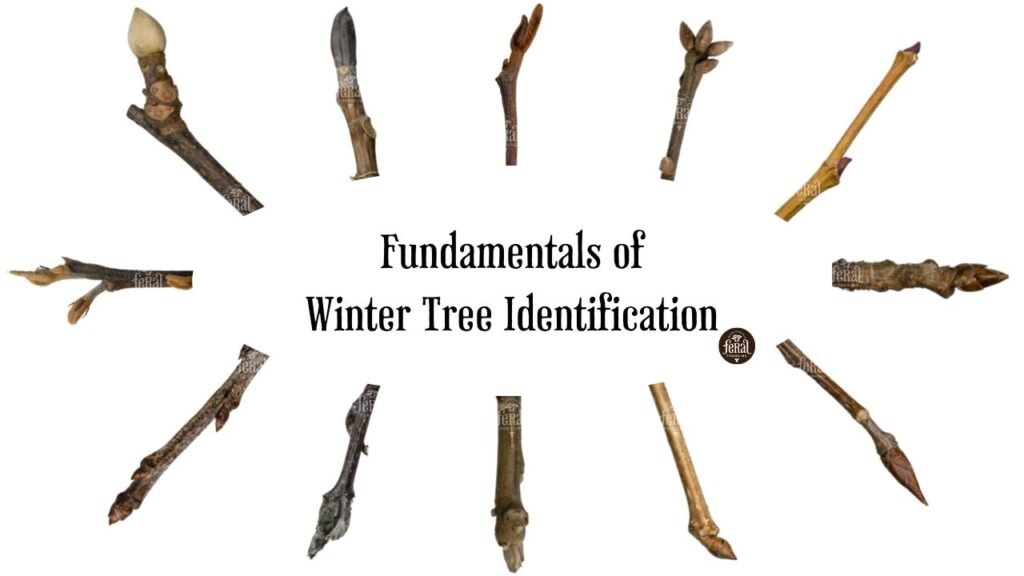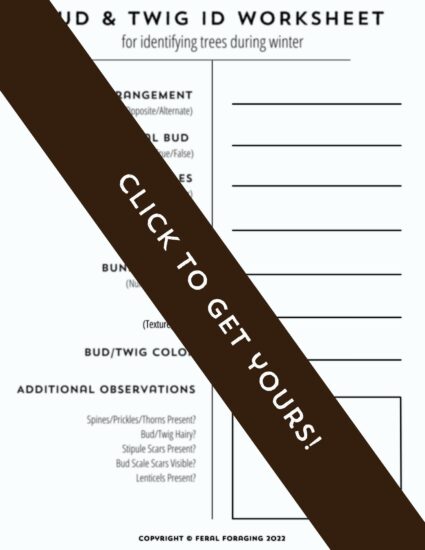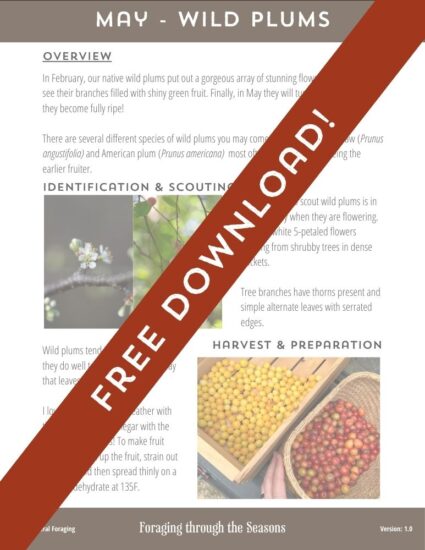How to Get the Most out of this Guide
Welcome to the Ultimate Guide to Winter Tree Identification pat of our Ultimate Guides series! This information rich article is designed to give you all the information that you need to become proficient in winter tree identification. The article will likely take you more than one sitting to complete. We recommend consuming it in chunks, learning some information, applying it in the field and then learning more.
You can use the Table of Contents on this page to jump to the section you left on. Be sure to bookmark this page so you don’t lose it!
Last, if you find the information in this article valuable, we would love if you could share it with a friend, family member, or fellow nature lover! (You can use our social media buttons if you’d like)
This article is organized in the follow way. The first part will provide you with some background information, resources, and tips to get started. The subsequent sections outline the most important details to look for with winter tree identification (in order of importance).
We hope you enjoy the article! If you have any questions, please feel free to send them to us or join our discord foraging community! We love having new members to talk about plant identification and foraging with.
Winter Tree Identification Fundamentals
Winter Tree Identification, identifying trees without any access to their leaves that are so helpful for characterizing them. It sounds like a difficult task, but is it?
My answer is… No!
But it does seem difficult, and I think the reason is that we tend to focus on bark in the absence of leaves. Identifying trees by their bark is difficult. Bark changes over time and doesn’t provide many fine-grain details to utilize. However, there is another detail that is commonly missed…
It is incredibly distinctive and does not change over time. Please allow me to introduce you to the focus of this article.
Tree buds!
However, if you are here to learn more about tree bark identification, you can click here to learn more!
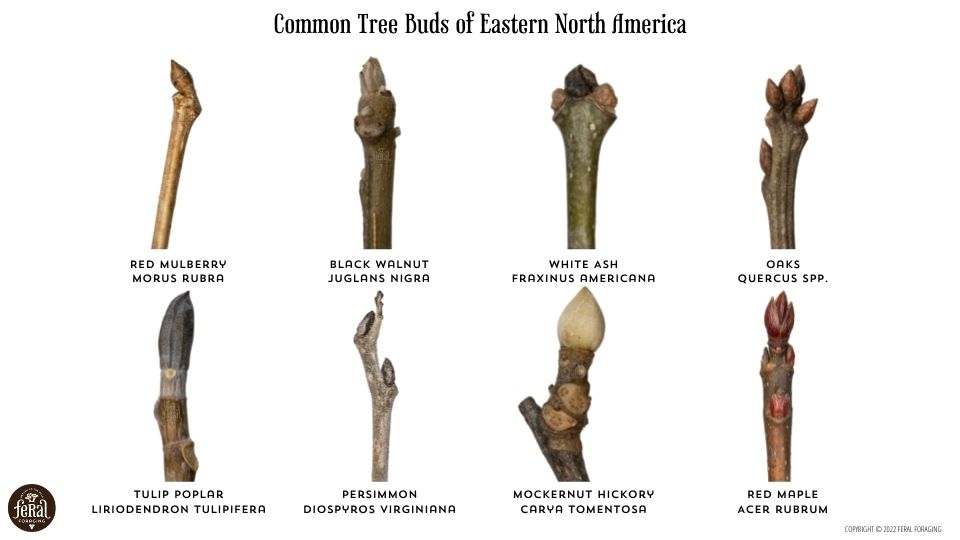
Looking closely at each of the buds in the above photo, if you studied any of these even if just for a little amount of time, you would never mistake one for another.
In this article, we’re going to go through the important details of tree buds detail-by-detail. By the end, you’ll be ready to go into the woods and start to recognize different buds and match them to their species!
Introduction to Winter Tree ID Video
If you learn better by video instruction, I made a full introduction video class which goes over the details outlined in this article in a video format! The class has passed now, but you can get a recording to watch at your convenience!
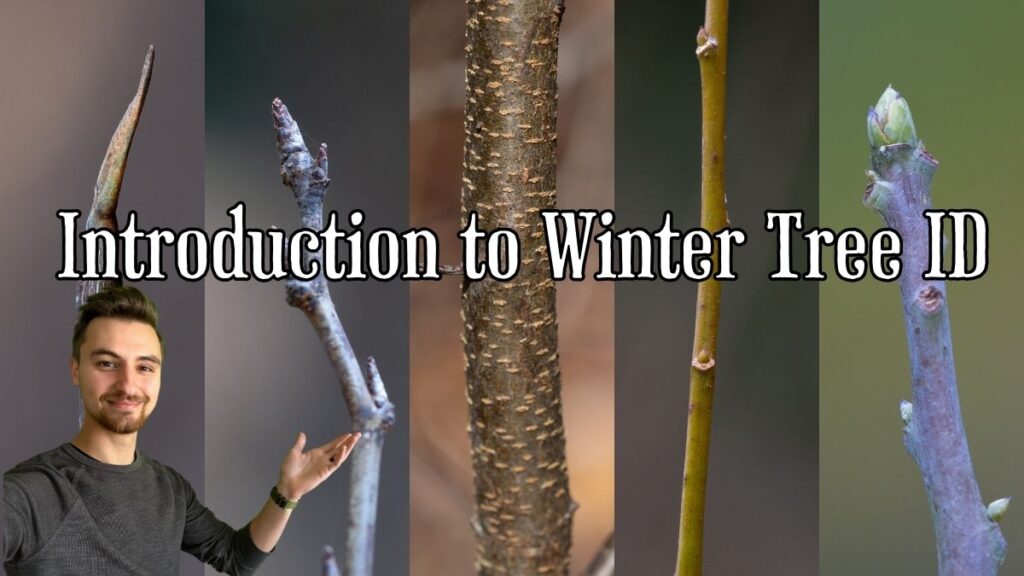
Equipment
First and foremost, I would recommend finding a good field guide to trees. If you are in Eastern North America like me, I have some recommendations you can see by clicking the button below.
I also highly recommend a ruler for taking measurements, a loupe for looking at small details, and a sharp knife for collecting specimens.
Recommended Equipment:
- Field Guide
- Ruler
- Loupe
- Knife
Quick Collection Tip
Label your buds in the field. This will allow you to use additional clues (bark, leaf litter, location, etc) later. I leave a number of notches on my buds with my field notes to reference later. I cannot tell you how many times I have lost an ID because I thought I’d remember the other details I noticed in the field, only to mix them up with the other twenty buds that I took home with me!
Winter Tree Profiles

I have created a set of downloadable winter tree profiles for wild fruit trees and trees with medicinal bark! These provide you with the most important characteristics to look for along with photos showing them. They will be a huge help to your foraging and winter tree identification journey!
I’m giving away the profile for Black Willow (Salix nigra) and Paw Paw (Asimina triloba) as a free preview that you can get by clicking here!
What is a Twig?
A colloquialism is to refer to any tiny branch as a “twig”. However when it comes to botany, a twig is more specific than that.
twig: the current or most recent growth at the end of a branch (1st years growth)
This is contrasted from a “branchlet” which is the 2nd to 3rd years growth and a “branch” which is greater than the 3rd year’s growth.
In winter tree identification we almost always use twigs, not branchlets or branches. This will be important in future sections such as Twig Pith.
Details of Winter Tree Buds
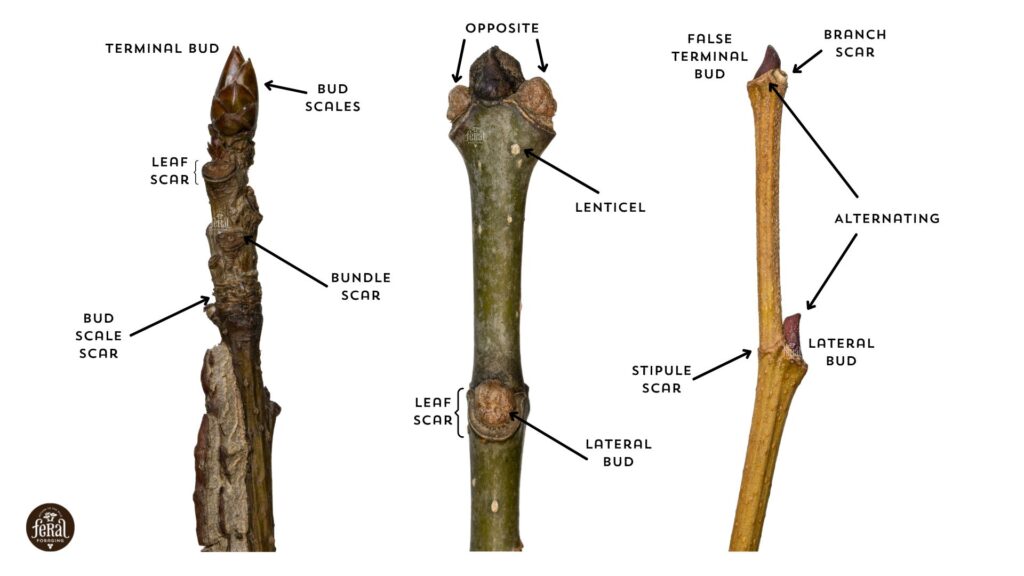
The details in this section are in order of precedence based on how you would find them in a field guide key for leafless trees. Each is important for gaining a positive ID of your winter tree bud. In the above photo you can see an annotated photo outlining the details that we are going to use and learn!
Bud Arrangement

This is the first detail that you should be seeking out when it comes to winter tree identification (as well as summer identification). We are looking for the pattern of how buds are arranged along the twigs, and branches. This will begin to narrow the different paths that we need to explore to get a positive identification.
Note: buds, leaves, twigs, and branches all follow the same arrangement within a species. If you don’t have access to the buds, look at the branches! They will also tell you the arrangement of the tree you are observing.
In regards to the photo above, sub opposite is considered “opposite” and typically won’t occur in every case within an individual. Ensure that you have gathered several samples of a single tree to prevent basing your identification off of an odd occurrence.
True or False Terminal Bud
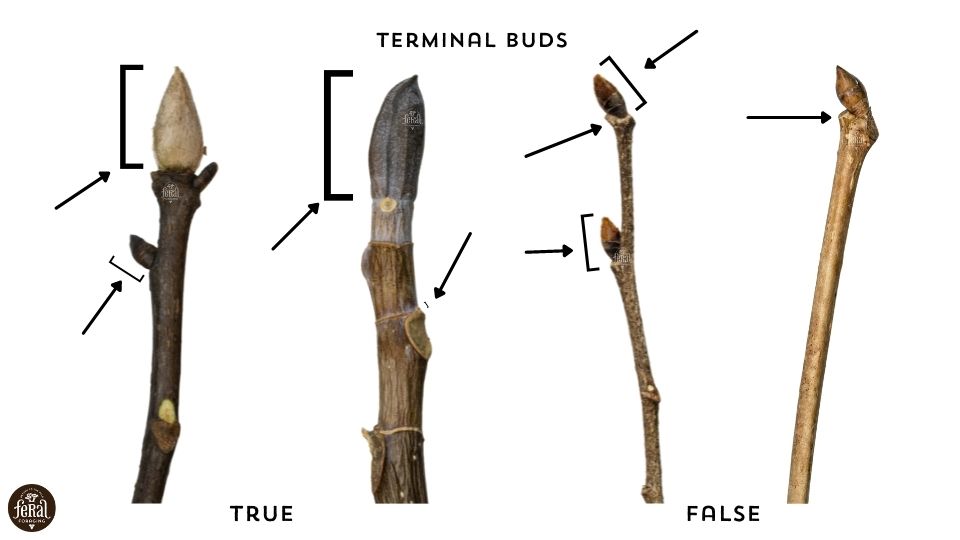
This is the second detail to look for in your bud as it typically appears immediately after arrangement in Winter Tree Keys. It is imperative to determine if your specimen has a true or false terminal bud.
A true terminal bud is where the growth of a twig/stem is terminated and where growth will resume in the springtime. Buds that do not terminate the twig/stem are called lateral buds.
Lateral buds are typically much smaller than terminal buds and often have fewer bud scales. Some trees have no terminal buds, but one might mistake the lateral bud closest to the end of a twig as a terminal bud, in these species we would call that a “false” terminal bud, or say it is lacking a terminal bud.
Because a false terminal bud is nothing more than another lateral bud, it will be roughly the same size as other terminal buds. Often you can find the end of the twig extending past the end lateral bud, further indicating that it is a false terminal bud.
It is particularly important to use multiple specimens to determine the presence/lack of a terminal bud as it is always possible that the particular specimen you are observing has a twig that was broken or has an atypical growing pattern.
This detail can be quite difficult to learn at first. Lean on your field guides to start to develop a sense of what true terminal buds and false terminal buds look like. More examples are shown below to help you.

Bud Scales
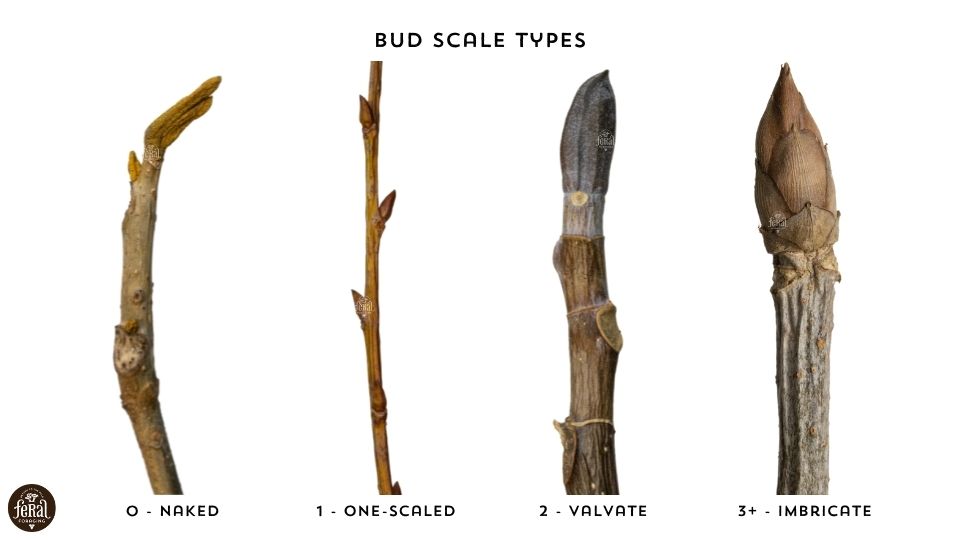
Bud scales are an adaptive strategy to provide protection to the immature leaf/flower inside. Some buds do not have any bud scales and are often called “naked” buds. Above are several different bud types that you will typically come across.
Types of Bud Scales:
- 0 – Naked
- 1 – One Scaled
- 2 – Valvate
- 3+ – Imbricate
In many cases, it isn’t of particular importance to know exactly how many bud scales a tree bud has, but more just which type it falls into.
Additional Bud Scale Details:
- Color
- Hairiness
- Color Change at the margin
- Texture
Twig Leaf Scars and Bundle Scars
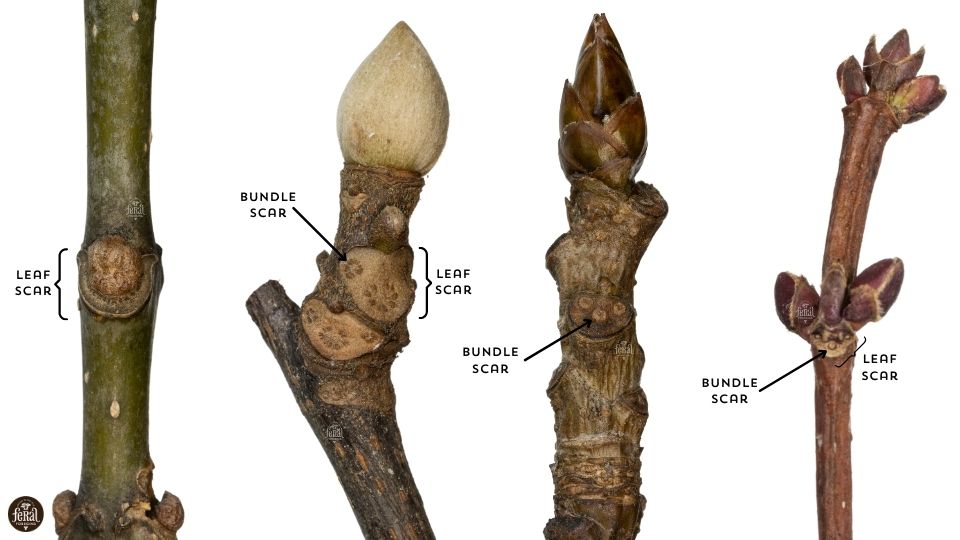
When the previous year’s leaf falls it leaves behind a leaf scar and within it vascular bundle scars. Bundle scars are where the “veins” of the leaf connected to the twig and the rest of the plant.
Above, in the maple and sweetgum specimens, we can see 3 distinct bundle scars per leaf scar. In many species the number of bundle scars is consistent so it is a good detail to always be on the lookout for. This is the case for sweetgum and maple.
Also, in the hickory bud, we see many different bundle scars. When there are so many that it would be difficult to count them all exactly, a field guide will typically label them simply as “many”. Note that the bundle scars appear to fall into groups. We would likely see a field guide description call this “3 groups of bundle scars”.
Leaf and Bundle Scar Details:
- Size of scars
- Number of bundle scars
- Position of bud in relation to leaf scar
- Color of scars
Twig Pith
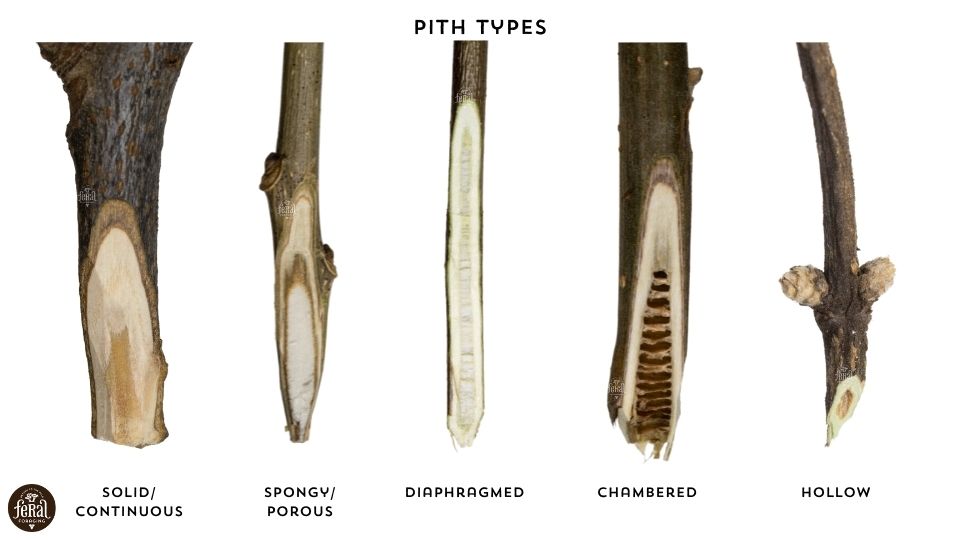
This is an often overlooked detail, but it is so helpful! Before we begin to observe the pith, we must ensure that we have a true twig. That means the growth only from the previous year and nothing older.
Above you can see examples of different pith types that are all incredibly distinguishable from one another.
Different Twig Pith Types:
- Solid/Continuous
- Spongy/Porous
- Disphragmed
- Chambered
- Hollow
Solid is woody on the inside – this may also be called “continuous”. Spongy/Porous is a distinctly different material and texture from the outer twig surrounding it. Diaphragmed is overall spongy with partitions separating them. Chambered is like diaphragmed, but hollow between the partitions. Hollow is completely empty on the inside.
Additional Twig Pith Details:
- Color
- With
Pith also has implications for how strong a twig is. Next time you cut a twig for observation. Pay attention to how difficult it is to cut!
Those are all of the most important details to look for and make note of with every bud that you are trying to identify. I understand that this can be a lot to keep track of in the field, see below for a solution!
Twig Hairiness (Pilosity)
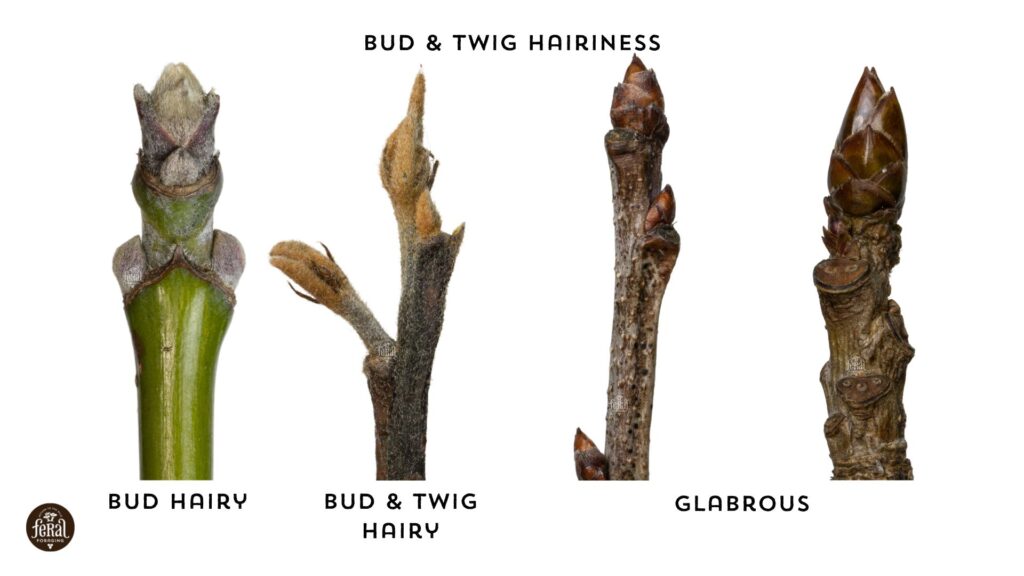
One of the more obvious details that we can find on buds is their hairiness or “pilosity”. In botanical terms, you’ll likely come across the term “glabrous” for smooth buds and twigs and the term “tomentose” for hairy buds and twigs.
Pilosity is a great distinguishing feature in some situations of lookalikes such as Slippery Elm, Ulmus rubra, which is typically very hairy and American Elm, Ulumus americana, which is typically only sparsely haired.
In some instances, only the bud is hairy. In other instances both the bud and twig are hairy. Sometimes the hair will be tough and give the bud or twig a rough texture. Other times the hairs may be fine and the texture will remain smooth overall.
Twig Lenticels
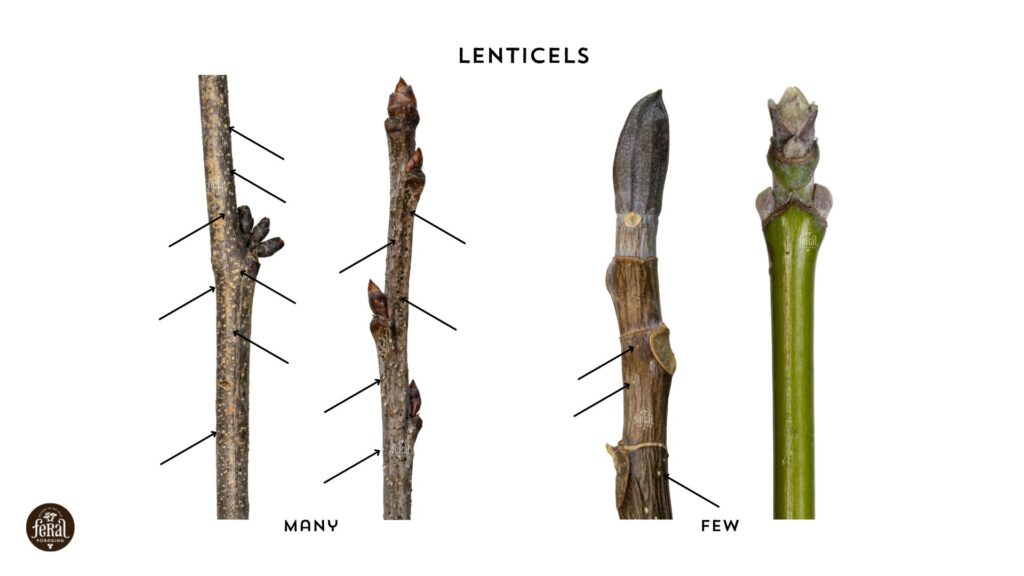
Lenticels appear as visible dots on the surface of twigs. They are used for gas-exchange in the plant’s respiration, allowing the plant to “breath”. In most cases lenticels disappear as the twig ages into a thicker branch or trunk. However, in some cases the lenticels will remain even with greater age. This is one of the characteristics that we can look for in trees like, Cherry, Sumac, or Paw-Paw.
When using lenticels we look for their presence, color, and abundance.
Twig Thorn, Prickles, and Spines
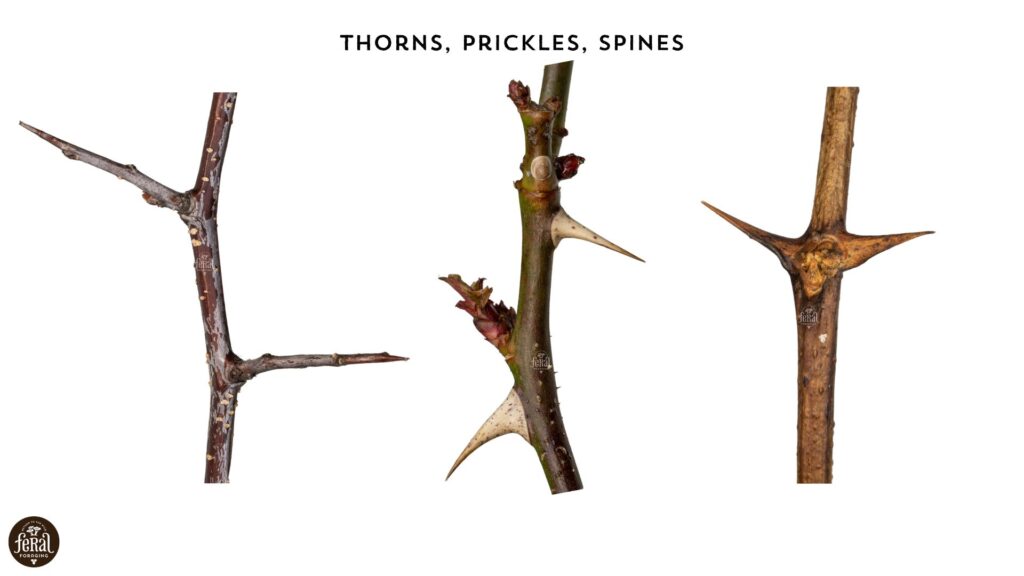
We colloquially refer to all sharp appendages of plants that may prick us as “thorns”, but technically there are three different types of these features. They are, “Prickles”, “Spines”, *and* “Thorns”.
To learn more about them, see this article by the Washington Native Plant Society.
The presence of any of these sharp appendages can often make our job easier of identifying a twig that contains them as there are fewer tree species that contain them than those that lack them.
Fun trivia: “Every rose has its thorn” is not botanically correct. If you wanted to be botanically accurate, you would have to say, “Every rose has its *prickle*”!
Twig Stipule Scars
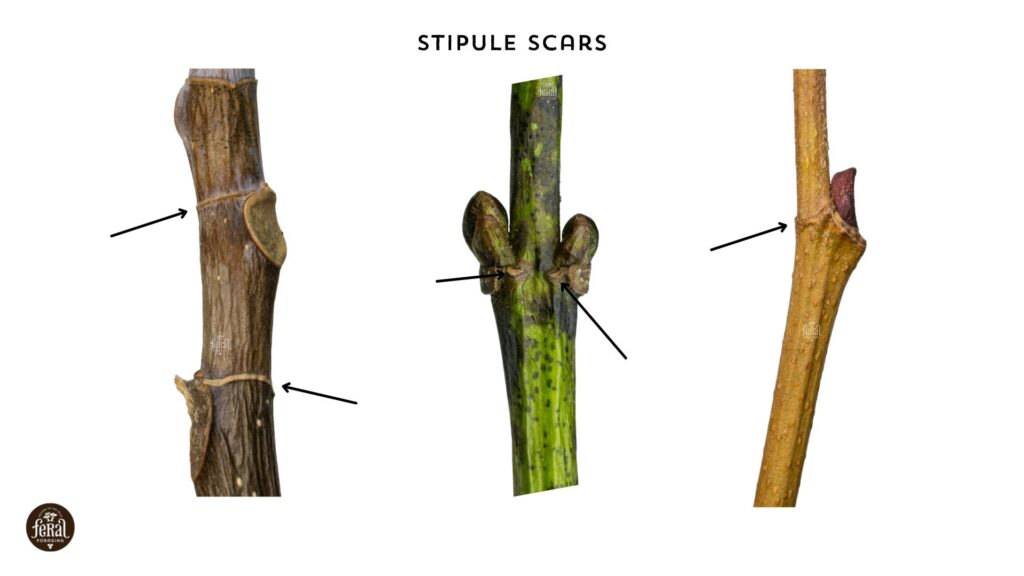
We have already learned about how a leaf *leaves* behind a scar in the Leaf Scars an Bundle Scars section. However, in some instances, plants produce “stipules”, small leafy appendages, which grow at the base of a leaf node as well. When they fall, they often leave behind a scar as well, called a “stipule scar”.
These scars usually manifest as horizontal lines next to leaf nodes that wrap around part of or the entire twig.
Common trees that have this feature include: Tulip Poplar and Sycamore.
Bud Scale Scars

When growth continues through the terminal bud or pseudoterminal bud it will sometimes leave behind scars from the bud scales that were present. This looks like a series of close circular ridges completely surrounding the twig or branchlet. As the branchlet ages into a branch, the bud scale scars will disappear into the bark. However, in younger twigs and branchlets we can use bud scale scars as an indication of age. Between two bud scale scars is one year’s growth!
Two trees where we can easily see bud scale scars are beech and sweetgum.
Super Imposed and Collateral Buds
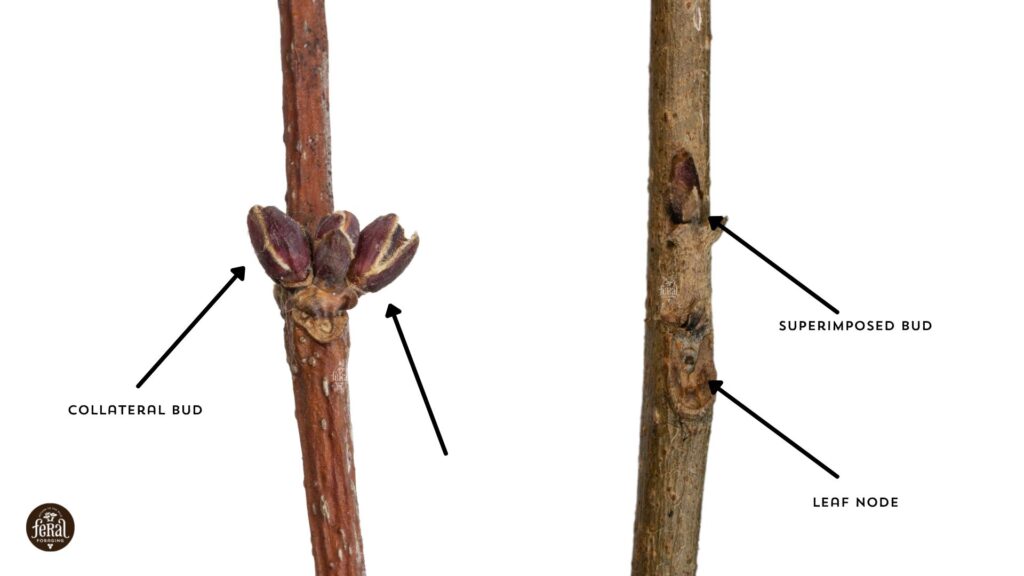
Sometimes you will find multiple buds arising from the same leaf node. This will usually be in two different forms: “collateral buds” or “superimposed buds”.
The most common instance of collateral buds occurs in maple (Acer) species like Silver and Red Maple (Acer saccharinum and Acer rubrum). This looks like two or more buds horizontally next to the main bud at a leaf node.
A superimposed bud is just like a collateral bud, but in a vertical sense. Here multiple leaf buds will be stacked upon one another. You can see this occurrence in species like Spicebush (Lindera benzoin).
Bud Description Worksheet
I made a worksheet that contains all of these details (and more) so you don’t have to remember them when you are out in the field! You can get yours for FREE by clicking the photo or button link below!
Tree Bark Identification
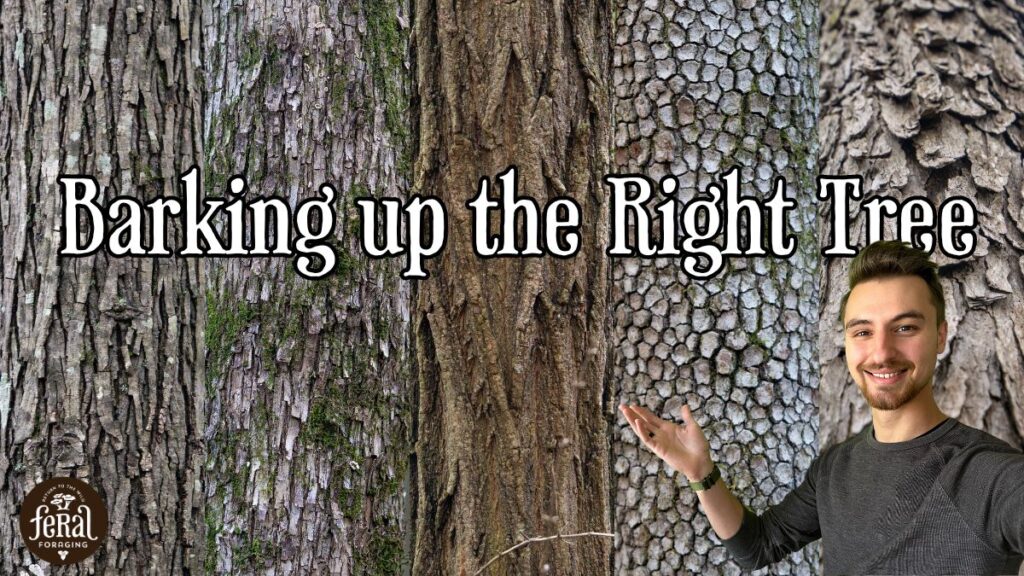
A lot of people asked for this, so I’m happy to announce that I have a class on recognizing tree bark now! As I mentioned in the basics video, I don’t recommend trying to start winter tree identification with bark. However, used alongside winter buds, bark continues to help us build our knowledge of trees.
The presentation breaks down a set of categories of bark patterns to help you better observe trees in the field!
You can watch the class here!
The information presented is based on the amazing book by Michael Wojtech called, Bark: A Field Guide to Trees of the Northeast. For reference, I am in the Southeast, but the underlying principles (and many of the species) are still completely relevant to me!
I cannot recommend this book enough!
Click here -> To Buy on Michael’s Website
Beginning Your Journey
Armed with the information in this article, you should be well on your way to a fruitful journey of Winter Tree ID. Now all you have to do is head to the woods to start gathering and identifying specimens.
I hope this helps you to be feral and keep foraging.


